Protesters Paint Graffiti, Dye Fountain Red, Interrupt Eisgruber at Reunions
The pro-Palestinian groups tried to keep up their messaging through “disruption” all weekend
Pro-Palestinian groups escalated their protesting on Saturday by painting graffiti, dying Princeton’s Fountain of Freedom red, and interrupting President Christopher Eisgruber ’83’s annual Q&A with alumni by chanting, shouting, and holding up hands covered in red gloves and red paint. They also made their presence known at the P-rade Saturday afternoon, chanting and carrying signs.
The words “pretty town bloody gown” appeared on Robertson Hall Saturday morning, the letters painted across the white columns. On social media, a student group that headed up the recent campus protest called the graffiti “a reminder to keep eyes on Palestine.”
At 10:30 a.m. a worker appeared to be pressure washing the graffiti off the building; by 1:30 p.m. the letters were covered with white poster boards. Hoses placed in the fountain were draining out the red water.
The move was one way pro-Palestinian protesters seem to be trying to keep the spotlight during Reunions, following their three-week encampment that ended May 15. On social media Friday, the student group — Princeton Israeli Apartheid Divest (PIAD) — wrote: “This weekend, act, disrupt, and escalate on your own terms — all tactics welcome.”
On Saturday morning, President Christopher Eisgruber ’83 spoke at an annual forum sponsored by the Alumni Association, held in Alexander Hall’s Richardson Auditorium. About 20 minutes in, local resident Joline Konson stood up and began shouting. Some alumni shouted “shame” at Konson, and two Public Safety officers talked to Konson for about a minute while Konson continued to shout about Princeton’s complicity in genocide.
As a video began to play on the stage as part of Eisgruber’s presentation, about 50-60 people in the audience silently held up their red hands while still sitting. When Eisgruber resumed speaking, Konson stood up and began shouting again. Public Safety officers then led Konson from the room.
As Konson was being taken out, the protesters with red hands began to chant and marched out of the auditorium. Again, several alums in the audience shouted “Shame” and “Let him talk” at the protesters. Eisgruber watched them go but when they had left the room, he noted that they had left just as the question-and-answer part of his presentation was about to begin. The first alumni who spoke praised Eisgruber’s handling of the protests and received loud applause.
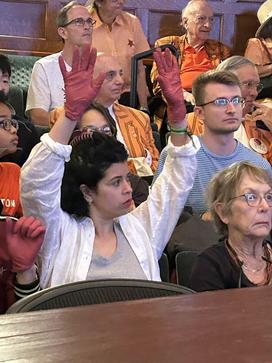
After the protesters walked out, Eisgruber addressed the audience, saying, “Protest is OK, disruption is not. Protest is important. It’s an important part of what goes on on a college campus as people move through this stage of their lives.
“We want students to be engaged around issues of justice and that’s really important. So some of this represents things that I think are part of what we need to do at Princeton and the kind of engagement that we have.
“But on the other hand, if people are taking over buildings, if they are vandalizing property, or if they are making it impossible for us to have a discussion, then at that point we need to take action. Because under those circumstances we cannot have the discussions that are important.”
After the protesters left, several small speaker-like devices they apparently left under their seats went off at intervals with pro-Palestinian messages. At least three were confiscated.
The entire protest lasted about seven minutes.
Outside Richardson, the protesters continued to chant. When Public Safety officers blocked the entrances, the protesters chanted, “PSAFE, KKK, IDF [Israel Defense Force] They’re all the same.” Public Safety eventually closed the doors to Richardson but had to move some protesters out of the doorway. Princeton town police officers also arrived on the scene.
It’s unclear whether anyone was arrested.
Ken Mayers ’58, wearing a pro-divestment T-shirt and a keffiyeh around his shoulders, said he had walked out with the students “because I think the University has failed to negotiate with the protesters, who have a perfectly valid argument.” Mayers said he supported the walkout but not the protester who shouted during Eisgruber’s talk. “I didn’t think it was appropriate to stand up shouting,” he said.
Rutgers professor David Hughes ’89 said he had been involved in the encampment at Rutgers. He said he brought red paint into Richardson with him and applied it to his hands while Eisgruber was speaking.
Roger Woolston ’55 said, “I think it’s OK. They weren’t really disruptive. But I’m glad it hasn’t gotten violent.” Virginia Smith ’83 also said she thought the protests were appropriate. “Protests are supposed to be uncomfortable,” she said. “If they’re not uncomfortable, they’re not noticed.”
“I’m very proud of the way the president handled it because he obviously is trying to live his values, and it’s very uncomfortable and he’s got a complicated job, but there’s such strong feelings,” said Jerry Kunze ’77. “So, I think he’s honoring that by allowing people the chance to protest, but to keep it in a context and in a way that the issues can be discussed without escalation. And we can hopefully move forward together.” His wife Beth agreed and added, “I didn’t feel threatened personally, I just felt bothered by the situation.”
“I respect that there’s a point of view, [but] I don’t approve of the tactics,” said Bob Auray ’73. He added, “I’d have more respect for these folks if they’d go over and fight. Go join the cause, defeat the Israelis if you’re really serious. Get armed and don’t fight with me, go fight over there.”


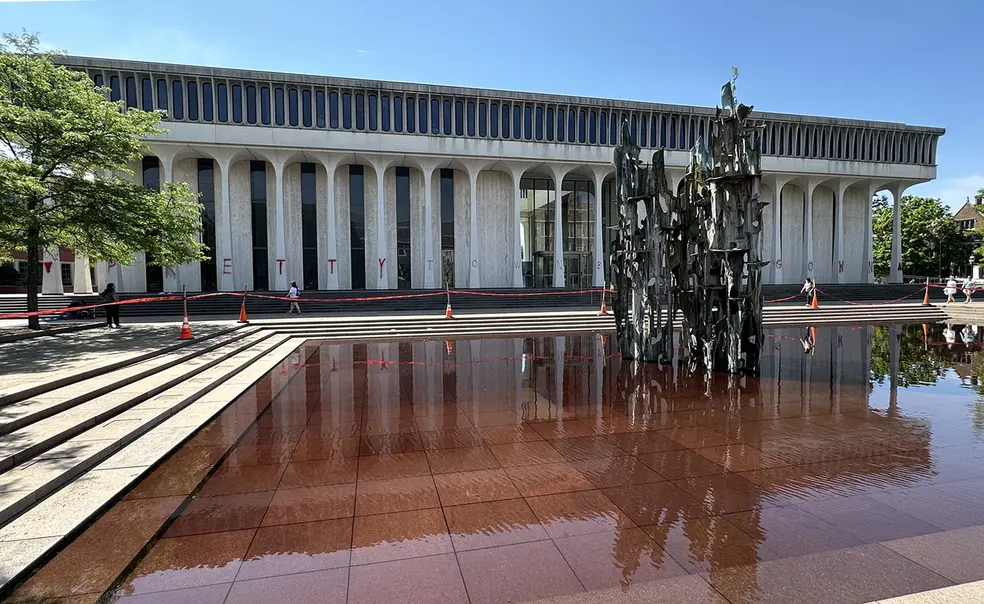
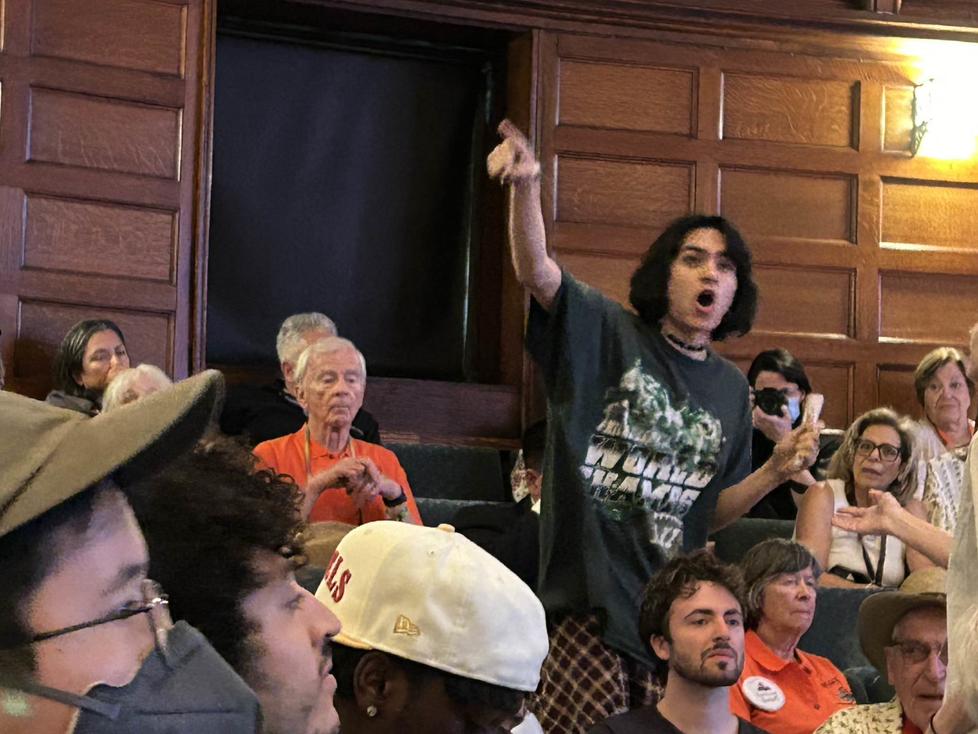
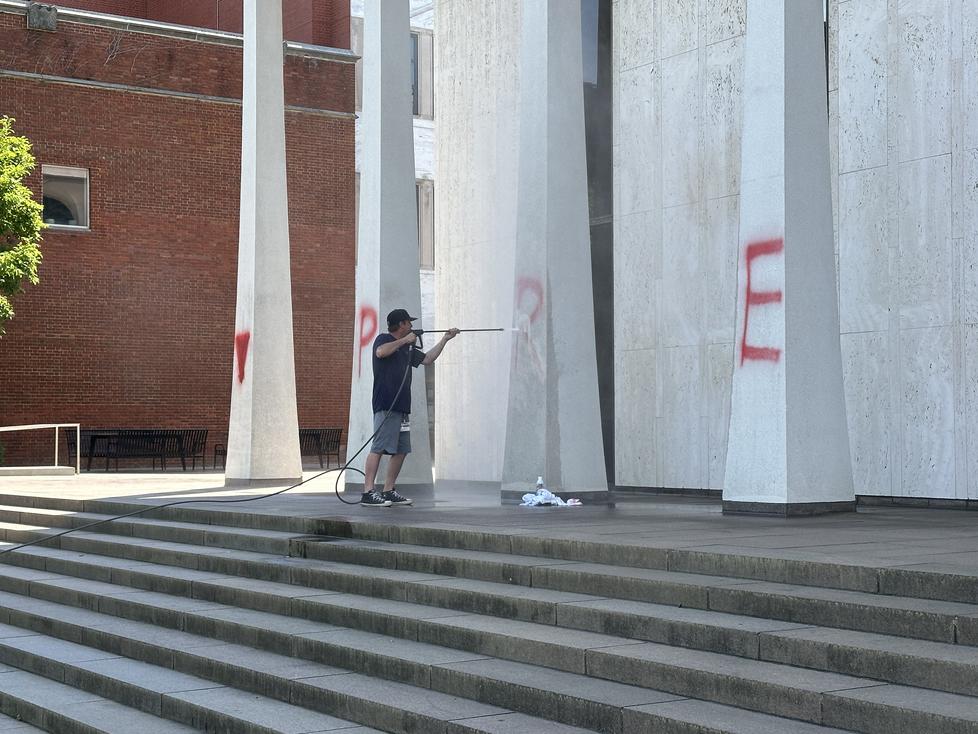
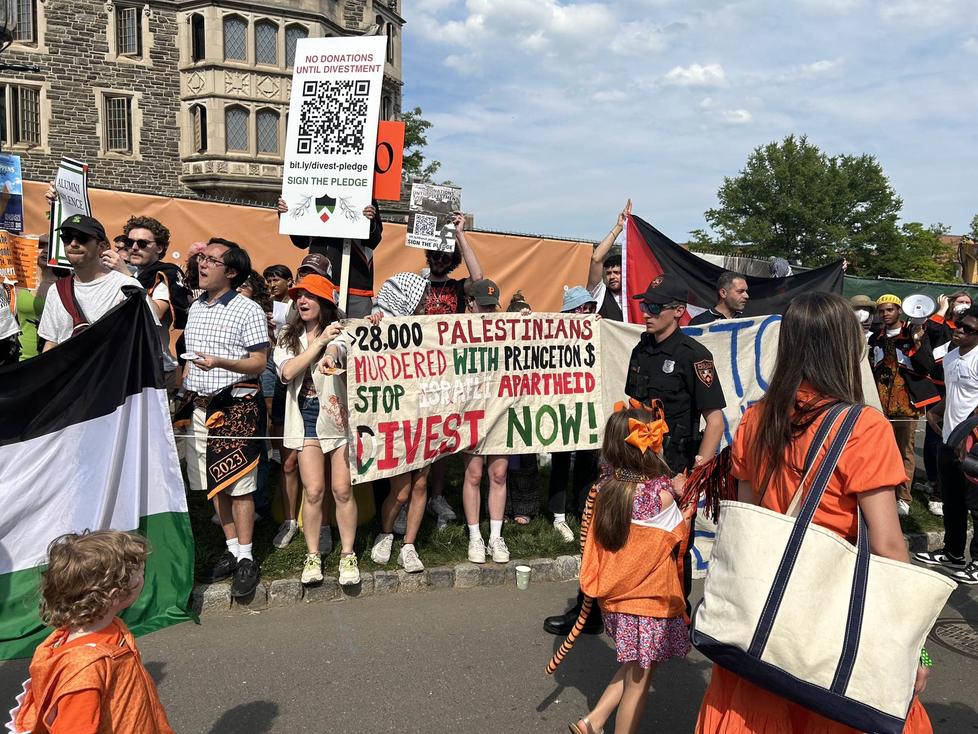










9 Responses
Eve Gendron ’88
1 Year AgoProtesters’ Vandalism, Demands Are Misguided
Returning for Reunions, I was saddened to see the beautiful Public and International Affairs building defaced with spray paint, and the fountain dyed red. Many student protesters’ actions and demands seem misguided for several reasons:
Bill Hewitt ’74
1 Year AgoCondemn Hamas and its Atrocities
Complicity in the wrongful shedding of blood was the theme to the disruptions of President Eisgruber’s address at Alexander Hall and recent landmark vandalisms. This raises, with apology to Florence Reece and her 1930s protest song “Which Side Are You On,” the question, “Which ‘genocide’ are you on?”
According to urban warfare expert John Spencer, in Gaza, Israel “has gone to unprecedented lengths, not seen in the history of modern warfare, to abide by the laws of war and avoid harm to civilians, even when doing so puts the IDF's own soldiers at risk.” Hamas pursues the opposite. The overriding effort of the Hamas Oct. 7 surprise attack from Gaza was to kill, rape, torture, and kidnap Israeli civilians, constituting the deadliest day for Jews since the Nazi Holocaust. In further perversion of morality, Hamas seeks not the protection of Gazan civilians, but instead purposely puts them in harm’s way and uses these avoidable Gazan deaths for the sake of mendacious propaganda. The Hamas leadership promises more attacks on Israel and seeks its annihilation — “Everything we do is justified,” a Hamas official said in late October.
Princeton Students for Justice in Palestine (SJP) issued a statement shortly after the Oct. 7 events that dismissed the meticulously planned military invasion as an “uprising” and never even mentioned Hamas or its goals to annihilate Israel. This SJP statement instead not only held Israel “ultimately responsible” for the loss of life but denied any culpability whatsoever on the part of Gazans or Hamas for the attack on Israel and the ensuing war. In its Reunions briefing package, Princeton Israel Apartheid Divest (PIAD) included an essay by Steve Salaita in which the author denies Israel the right to defend itself, “In short, there is no such thing as Israeli self-defense. It is a categorical Impossibility.” Elsewhere, PIAD proclaims, “We honor every martyr lost to the occupation.”
In their zeal to be pro-Palestinian and their efforts to depict Israel’s efforts of self-defense as “genocide,” PIAD and SJP brazenly ignore Hamas’ goal and actions to annihilate Israel. Symbolically raising their red hands of protest against Israel’s actions, these PIAD and SJP protesters stand morally submerged in the blood Hamas wrongfully sheds.
I stand with Israel. Those Princetonians who don’t should at least condemn Hamas for its atrocities against the peoples of Israel and Gaza.
Leonard J. Nissim ’72
1 Year AgoThank You
Thank you to Bill Hewitt. You have said what needed to be said, in greater detail and with more eloquence than I could manage.
Ron Cohen ’77
11 Months AgoDismayed by SJP, PIAD Positions
Bravo, Bill Hewitt, for underscoring the amorality and hypocrisy that characterize the positions of SJP and PIAD. It’s dismaying to see students who have proved worthy of admission to Princeton give themselves over so carelessly to bigoted, dehumanizing sloganeering, unmoored to scholarship or study.
Jocelyn Goldberg-Schaible ’74
9 Months AgoThank You, Bill Hewitt
Thank you, Bill Hewitt, for your ethical clarity and your courage. You recognize right versus wrong and good versus evil, and you are bold enough to do so out loud. You are one of today’s righteous ones, a true ally, and we are grateful.
Kenell Touryan *62
1 Year AgoHelp Palestinians in the West Bank
Students at U.S. colleges, including Princeton, who do not know even how to spell Palestine, where the West Bank is, and who really are the long-suffering West Bank Palestinians, are disturbing and disrupting important end-of-school-year functions.
If they really want to help the West Bank Palestinians, go join them where they are!
A former Palestinian citizen,
Richard M. Waugaman ’70
1 Year AgoLet’s Not Lose Our Focus On Gaza
Thank you for this article. I do worry that the student protests have led to a counterproductive backlash, with too much attention devoted to the controversy over the protests themselves, and too little attention devoted to Israel’s relentless attacks on those in Gaza — Hamas terrorists and innocent civilians alike. Today, I read that extremist settlers in the West Bank have been attacking trucks trying to feed those who are starving in Gaza.
Richard M. Schwartzstein ’75
1 Year AgoDisappointed in Princeton Administration
Despite the self-congratulatory elements of much of the reporting on how well the administration supposedly dealt with the demonstrations, I am greatly disappointed in the apparent willingness of the Princeton administration to invoke minimal if any disciplinary actions for the forceful occupation of a University building and the defacement of Princeton property. This will only incentivize similar activities in the future. Civil disobedience implies that you are willing to pay the price for unlawful behavior; the protesters should pay the price for their actions. It is not clear what a “restorative justice” requirement would be to allow a student to graduate or what the implications would be of “probation.”
I am also disappointed in the absence of discussion about the origins of this war. Hamas is a terrorist organization committed, by its own charter, to the elimination of Jews globally. The fighting could be over tomorrow — Hamas just has to surrender. If students are not aware of this, then Princeton education has some major problems; if they are aware and don’t care, then antisemitism is even worse than I thought on campus. Finally, Princeton has opened itself to future Title VI lawsuits, which have afflicted Harvard and other universities, since this environment is threatening to other students and perpetuates antisemitism.
Henry Von Kohorn ’66
1 Year AgoThanks to the PAW
Over the years, PAW has characterized itself as an editorially independent voice for Princeton Alumni — vastly different from most alumni magazines that tend to be house organs for university administrations. Many alumni may have considered this stance to be mere lip-service, but PAW’s recent reporting on the pro-Palestinian campus protests has demonstrated the validity and value of that independence. I congratulate the staff of the Princeton Alumni Weekly for presenting timely, complete, and balanced reporting of recent events, Lest we forget, your unique independent voice is one of the factors that help to make Princeton alumni among the most loyal in the world.